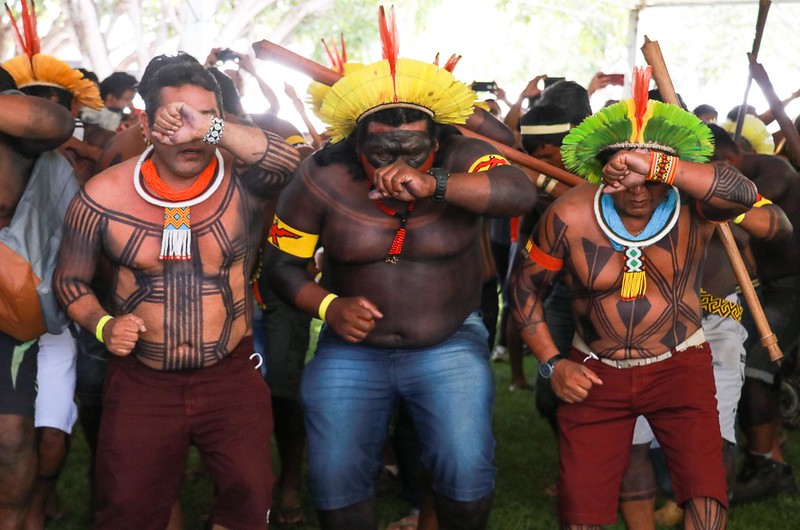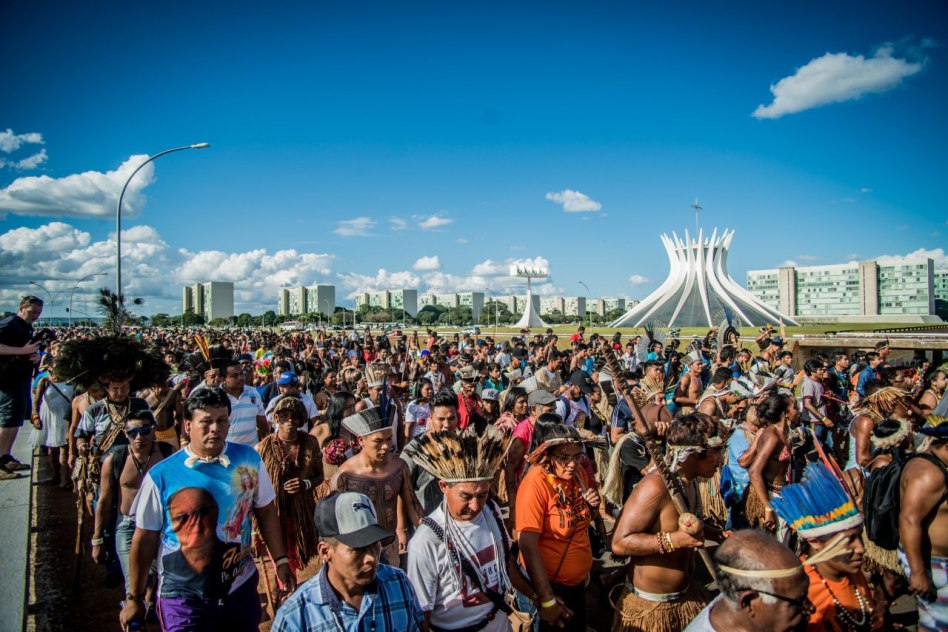
More than 3,000 indigenous people marched through the Esplanade of Ministries (Photo: MNI).
The camp smelled like smoke and urucum (a plant used for body paintings). The atmosphere pulsed with the energy of fight. Chants, ritual mantras and even cerimonial crying could be heard. The place was full with the voices of the more than 3,000 indigenous of more than 100 different peoples from all over Brazil who were united during five days in the Brazilian capital city, Brasilia, for the 2018 Indigenous National Mobilization.
“The fight is the legacy we leave for our children,” said Kretã Kaingang, indigenous leadership from the state of Paraná, member of the Articulation of Indigenous Peoples of Brazil (APIB, in the acronym in Portuguese) and coordinator of the indigenous program of 350.org Brasil.
The scenario of political setbacks and the strategies needed to resist the withdrawal of rights are the main thrust of the movement. The government’s reluctance on making the demarcation of indigenous lands and the criminalization of leaderships were also points of debate.
Kretã recalled the persecutions he has been suffering and the forced removal from his native territory. “I was imprisoned for a time, accused of crimes that were not proven and I have been prevented by a judge from approaching the land where I was born. For four years I couldn’t step on the place where my navel is buried,” he said.
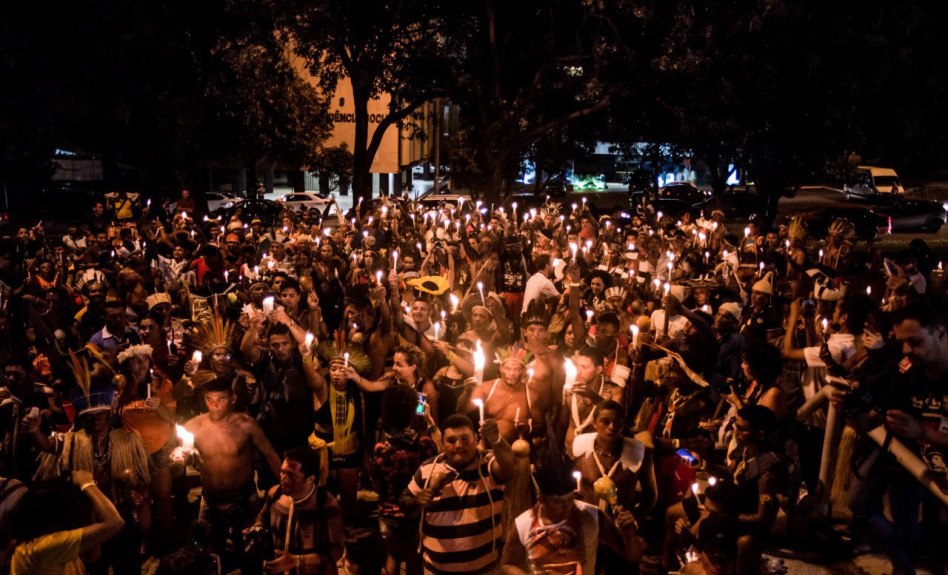
Indigenous leaders in vigil in front of the AGU building (Photo: MNI).
On the third day, the indigenous leaders went to protest in front of the Federal Attorney General’s Office, demanding the repeal of a law known as the ‘Genocide Opinion’, which in practice prevents all new processes for land demarcations. The night fell, and they remained there in vigil. Candles lit in fist, the diverse crowd stopped everything they were doing to listen to the song of lament sung by one of the indigenous woman present. It was a mourning ceremony.
The next day dawned and the Esplanade of Ministries, the main route which concentrates all the federal government buildings, was taken by the same tireless leaderships, that went down in march to the National Congress.
With paintings and adornments, dancing and singing war cries, indigenous Kaingang, Guarani, Guarani-Kaiowá, Guarani-Mbya, Xucuru, Pataxó, Munduruku, Awá-Guajá, Guajajara, Marubo, Xerente, Xavante, Kayapó, Tenetehara, Tembé, Tucano, Krahô, Kanela and many others demanded the resumption of the demarcation processes of their lands and respect for their rights hard won in the Constitution of 1988.
On the banners, messages to the authorities: “Demarcation Now!”, “Fracking in our lands, No!” and “Guarani resists”. Other signs also denounced the destruction of territories, rivers and natural resources by energy and infrastructure projects.
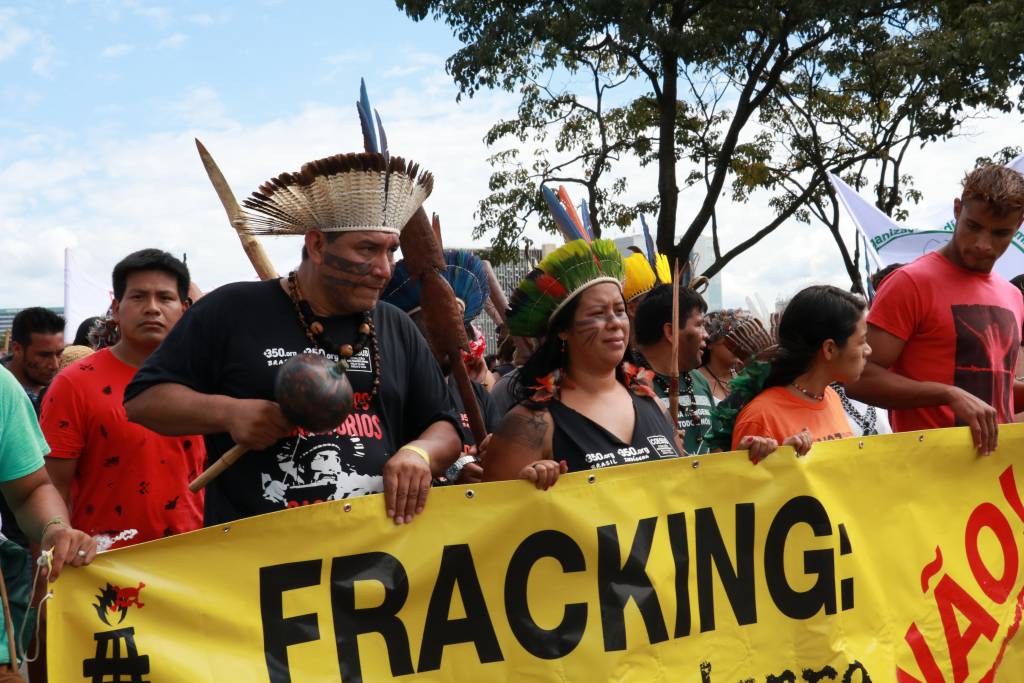
Banner with the message “Fracking in our lands, No!”, from 350.org Brazil and COESUS, carried by the Kaingang people (Photo: Melissa Teixeira / 350.org / COESUS).
“We have only one objective here: to resume the process of demarcation of our lands. We came to represent our communities, but many could not come along with us. And we can not leave our relatives dying on the ground,” said Kretã Kaingang.
During the demonstration, the street was stained in red, symbolizing the blood of the leaderships shed in so many acts of barbarism that have been committed, in a true historical genocide against these traditional populations.
“The trail of ‘blood’ we leave represents the violence and attacks imposed by the state to the original peoples of this country. Several invasions, threats and assassinations have been occurring in Brazil, in addition to a cruel process of criminalization of the leaderships. But despite this problematic conjuncture, we will always resist and fight, as we learned from our ancestral warriors,” said chief Marcos Xukuru of Pernambuco.
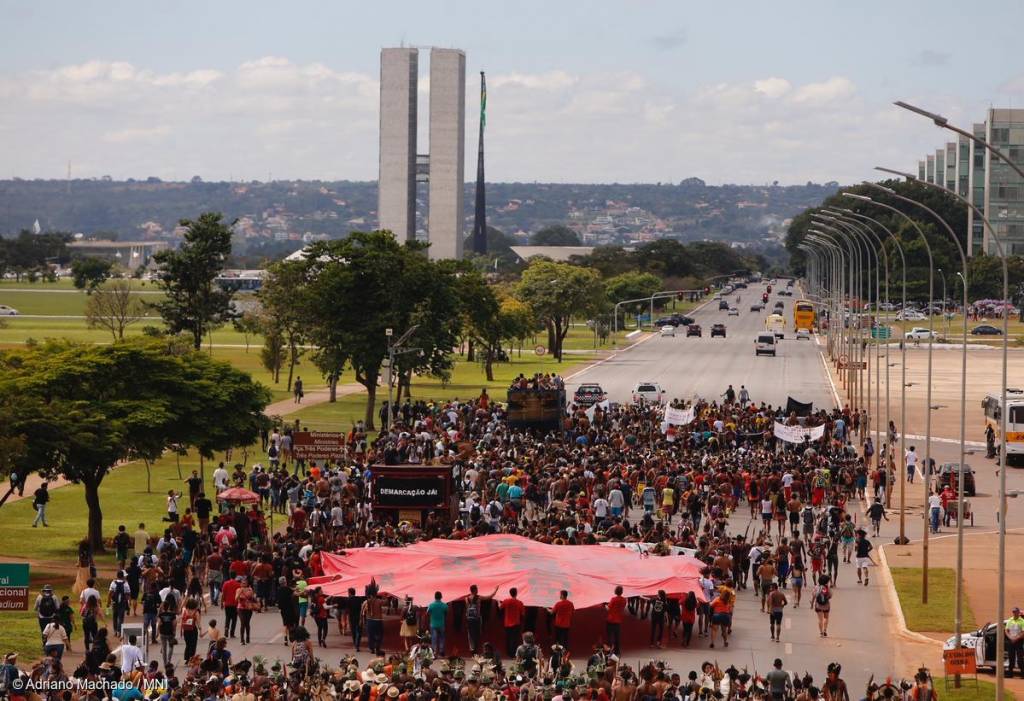
Joênia Wapichana, the first female indigenous lawyer to stand up in the Federal Supreme Court, recalled what is really at play: “The fact that the Executive Branch has an instrument to restrict the right to demarcation puts the lives of all indigenous peoples at risk, whose subsistence depends directly on the land and everything it gives.”
“The demarcation of our lands is their preservation. We have heard reports from our relatives from all regions about invasions pursued by loggers, prospectors, grabbers and state enterprises. What we want is to ensure the lives of future generations. We fight here not only for us indigenous peoples, but for the Brazilian society as a whole,” said Tupã Guarani Mbya, from the Indigenous Land Tenondé Porã, in São Paulo.
For the chief Juarez Munduruku, indigenous peoples are like trees. “There’s life in the trees just as there is in us. If you kill them, they die and never come back. If a logger kills a ‘cacique’, a story ends.” He recalled that in the middle of the Tapajós River, in the Amazon, where his territory is located, there are projects to 43 hydroelectric plants (two already carried out, whose dams kills their rivers and their way of life) and 30 soybean ports, in addition to mining and illegal logging.
The National Indigenous Mobilization – also known as the ‘Free Land Camp’ – is carried out by the Articulation of the Indigenous Peoples of Brazil for 15 years now, and counts with the support of several indigenist, socio-environmental and climate organizations, such as 350.org Brasil and the No Fracking Brasil Coalition (COESUS).
